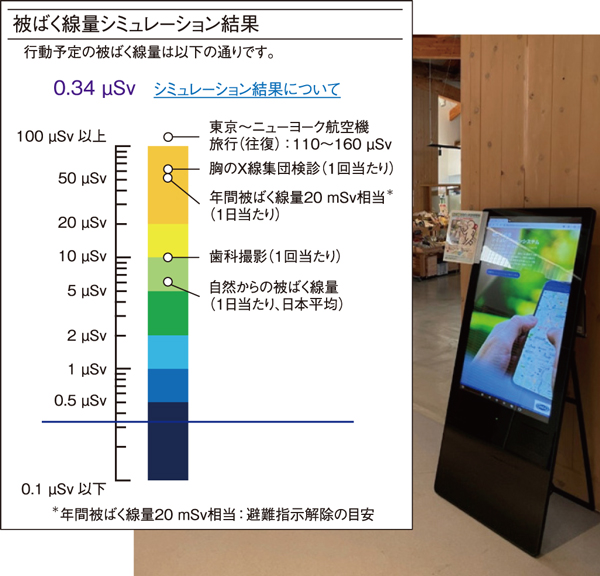Assessment of Exposure Doses and Decontamination
(2024)
QWhat efforts are you making to release the difficult-to-return zones where residents can feel safe?
ASince the accident, various government agencies have been assessing radiation doses using individual dosimeters. Simulation-based assessments have also been studied to evaluate collective exposure doses and to predict exposure doses.
Through these assessments, residents' exposure doses have been assessed and managed, and the assessment results have been provided to local governments as part of risk communication to reduce health concerns. In addition, an exposure dose assessment system that allows residents to estimate their own exposure doses has been introduced in local governments.
The knowledge and experience of external exposure dose evaluations, which were conducted in projects by various governmental organizations, after TEPCO’s Fukushima Daiichi Nuclear Power Station accidents, are useful for lifting the evacuation orders related to radiation protection and risk communication. However, the objects and means of the evaluations differed, and the knowledge and experience gained still have to be organized. This study reviewed the various evaluations and summarized the methods and characteristics of the evaluations.
For the risk communication with residents, governments directly evaluated individual doses by using personal dosimeters (Fig.1). This evaluation enables assessing the practical exposure dose of individual residents.

Fig.1 Summary of projects on individual dose evaluation
The projects on the individual dose evaluation conducted by central and local governments are categorized based on the implemented matters.
In addition to the individual doses, exposure doses of population can be assessed via simulation by combining the measured individual doses and variations in factors affecting individual doses, such as the distribution of radiation in the fields (e.g., ambient dose equivalent rate), location (outdoor/indoor), and time spent, and presence of buildings. However, it is difficult to apply these methods for exposure dose prediction because these methods require the direct measurement of the individual dose.
Projects were conducted to assess exposure doses for individuals and populations by using models with parameters representing the aforementioned factors affecting doses. These models allow for retrospective evaluation by using actual values for the parameters of the individuals and populations to be evaluated and also allow for predictive evaluation by using assumed parametric values.

Fig.2 Exposure dose simulator installed in towns
An exposure dose simulator was constructed based on the review of risk communication and was installed in towns. This system enables the easy estimation of the exposure dose by inputting the migration pathway and staying time using a touch panel.
This review also summarizes the concerns to be addressed for these methods−for example, the uncertainties of direct measurements using personal dosimeters and parameters in the models. To adequately select the methods to assess the exposure dose, it is important to address these concerns.
Based on the review of risk communication, an exposure dose simulator was designed and installed in four towns as a tool for communication between local governments and residents (Fig.2). Additionally, exposure doses calculated by the simulator were provided to the Decontamination Verification Committees in each local government and used for decision-making regarding lifting the evacuation orders. These results are also expected to help make decisions regarding lifting evacuation orders in the future.
This study was supported by the “FY2021 Study Project for Utilization of Individual Dose Data in Fukushima Prefecture” organized by the Cabinet Office, Government of Japan.
Related articles
- In what ways does exposure to radiation occur the environment? What kinds of radiation exposures are important in Fukushima?
- What kind of unit is used for the evaluation of radiation dose? What is the relationship between the unit and air dose rates?
- Why are radiation doses measured with personal dosimeters different from those estimated using air dose rates?
References
- Sanada, Y., Yoshimura, K., Sato, R., Nakayama, M. and Tsubokura, M. (2023): External Exposure Assessment in the Fukushima Accident Area for Governmental Policy Planning in Japan: Part 1. Methodologies for Personal Dosimetry Applied After the Accident, Journal of Radiation Research, vol. 64, no. 1, 2-10. https://doi.org/10.1093/jrr/rrac079
- Yoshimura, K., Sanada, Y., Sato, R., Nakayama, M. and Tsubokura, M. (2023): External Exposure Assessment in the Fukushima Accident Area for Governmental Policy Planning in Japan; Part 2. Matters to be Attended for Assessments of External Exposure, Journal of Radiation Research, vol. 64, no. 2, 203-209. https://doi.org/10.1093/jrr/rrac088
